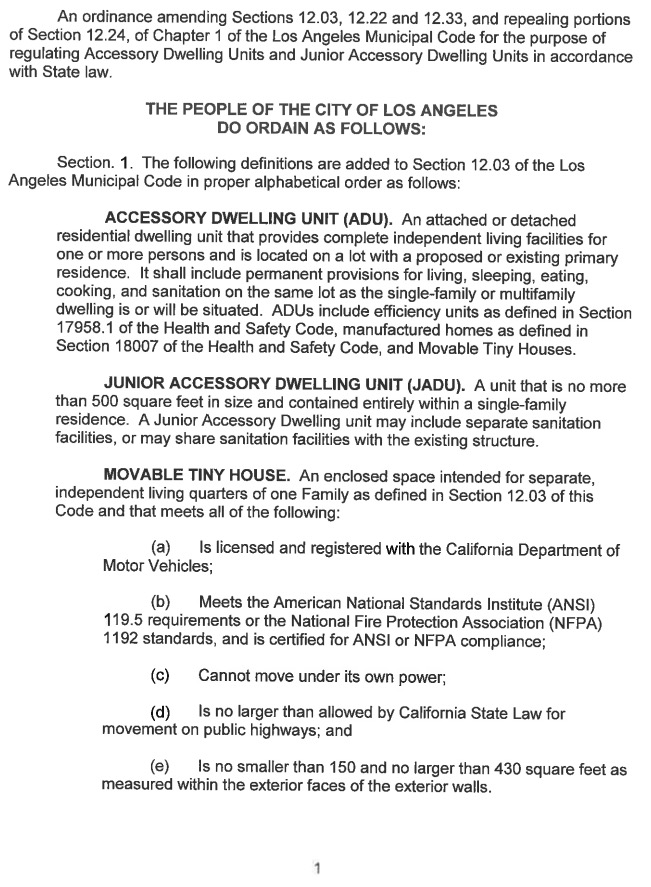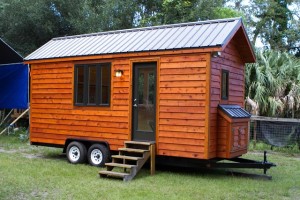This post contains affiliate links.
According to the Tiny Home Industry Association, LA has made backyard tiny homes on wheels legal as accessory dwelling units. It is called LA 2019-12-5 ADU Ordinance R19-0408.
It was just approved by the Los Angeles City Council, pretty incredible, right? One of the largest cities in America has just approved of tiny houses on wheels, I wonder who will be next?
Don’t miss other awesome updates like this – join our FREE Tiny House Newsletter for more!
Los Angeles Legalizes Tiny Houses on Wheels as ADUs


Image via a tiny house resort, the oki tiny house, ESCAPE ONE
Learn more
LA Gives Greenlight to Moveable Tiny Houses | LA 2019-12-5 ADU Ordinance R19-0408 | LA City Clerk
Our big thanks to Janet Thome for the tip!🙏
You can share this using the e-mail and social media re-share buttons below. Thanks!
If you enjoyed this you’ll LOVE our Free Daily Tiny House Newsletter with even more!
You can also join our Small House Newsletter!
Also, try our Tiny Houses For Sale Newsletter! Thank you!
More Like This: Tiny Houses | Articles | Discussion | THOWs | Zoning
See The Latest: Go Back Home to See Our Latest Tiny Houses
This post contains affiliate links.
Alex
Latest posts by Alex (see all)
- Her 333 sq. ft. Apartment Transformation - April 24, 2024
- Escape eBoho eZ Plus Tiny House for $39,975 - April 9, 2024
- Shannon’s Tiny Hilltop Hideaway in Cottontown, Tennessee - April 7, 2024






Great news on LA approving THOWs!
We live in Sonoma and are trying to facilitate acceptance as ADUs but stmbling block is inspection process to meet standards you cited..any thoughts?
Thanx, jim
Number of options…
1) Site built, which means it can be inspected during the construction just like a traditional house.
2) Shell, basic framing, etc. done but interior wiring and plumbing remain visible for it to then be inspected and once approved you can complete the build. This includes purchasing from a builder that offers said certification.
3) 3rd Party certification like NOAH support both commercial and DIY builds to certify it meets required standards.
4) Work with an engineer and or architect that will sign off on the construction… and thoroughly document, photograph, video, etc. the construction throughout the process to provide evidence…
They’re basically worried about liability, as long as someone signs off on it then you should be good…
On first blush, looks like great news. But, like you said, it’s going to be tough for many people to match the licensing and registration requirements as well as the inspection requirements. Many people go the THOW route so they don’t have to adhere to strict normal house building standards. That will affect many private and DIY builds.
Apparently one of the sections mentioned there allows full-time living in the THOW. That would be excellent news. Hopefully this will be a trend now; because as I understand it, most cities still don’t allow you to live in it full time.
I live in a bog standard home. I don’t live in it full time. Why, I go shopping. I go volunteering. I go… well you get the picture. Apart from housebound people and recluses, technically nobody lives in a home full time. Semantics? True, but that’s what lawyers (sharks that they are) love.
I just love this…….hurray for LA……..next should be Vancouver, and Toronto Canada……..and then I’d love to see cities turn vacant properties into tiny home communities for the homeless. This innovation is urgently needed NOW……put their money where their mouth is and not wait 2 to 5 yrs for public housing highrises to be built. Get high school shop students building tiny homes instead of pic frames, raises awareness, compassion and a project that actually helps someone regain their life and independence.
I just love this…….hurray for LA……..next should be Vancouver, and Toronto Canada……..
WooooHooooo!!! 😀 😀 😀
Now let’s go NATIONAL!!
What I find really amazing is that tiny houses started out as a homeless solution. Then someone promoted it as a luxury tiny footprint and knocked tiny homes right out of the park for homeless people. While trying to find supplies or resources to obtain or build a unit is now so out of financial reach for homeless, very low income, seniors, and disabled on SSI. Non profits, pha’s, and government entities have also gotten in the way because of petty squabbles, disagreements on how to run, adding services or not, but basically how are they going to profit off of it. Since there is no profit to be made, projects are dropped or pushed aside for other money making ventures. So where does that homeless appropriated money go? There quite a lot of it, and I’m not seeing homes for homeless. Just useless rerun programs to pass funds around the administration’s and cities government, and the eventually to the profit investment. And no one ever asks “where has the money gone for the homeless housing” and “Why isn’t it done?” Why is the money misappropriated, and why are homeless still on the streets. The federal grants received by counties should be building homeless housing communities, not paying themselves or reinvesting in other projects. Defeats the purpose. And the people on the street are still there. People still complaining. May KARMA kick you in the ass, and perhaps you’ll be next to experience homelessness.
“Tiny houses started out as a homeless solution”? That would be fine with me, but Henry David Thoreau (who died in 1862) is well known for advocating a more fulfilling life partly by living smaller (even though he did not have to for financial reasons), and he is often quoted in early TH essays. But it seems to be Jay Shafer who really got the TH movement going less than 20 years ago, who had lived in 3,000 sq. ft. and just got tired of it, IIRC.
That’s kind of my situation. My wife and I do fine financially, yet I’m tired of society telling me I have to own so much and live so high on the hog. Our house is 1260 sq. ft., and especially now that the kids are grown and gone, I really look forward to downsizing—waaaaaay down. (I do want a TH that’s made to outlast our grandchildren though, and I want to own the land it’s on.) I could give so many examples of wanting to downsize, like that after we bought the house 28 years ago, my parents gave us money for an oak dining set. It would have been nice to be able to say we don’t have room for it.
Unfortunately most local governments’ zoning laws don’t allow you to build a house of less than a thousand square feet anymore, or live full-time in a TH even if it’s legal to have it parked in a back yard. They might evict someone on the basis that it’s supposedly too small to be livable, or if it doesn’t have heating, or whatever, but they’re happy to throw the people out on the street to live in a tent and defecate on the sidewalk downtown L.A.. It makes no sense! So the article seems to be good news. It remains to be seen who will benefit from it.
Permitting and inspection fees certainly add to the costs, and materials and labor add up for even small structures. And in cities you need plumbing and (usually) electric hookups, same as a big house. But the main cost in my neck of the woods is land. Allowing tiny houses in residential back yards will help with that, but not enough to provide housing for all homeless people. Plus, there is endless demand for housing in coastal California. If a tiny house is added, it will be rented in an instant, and not for cheap. So yeah, this new ordinance in L.A. will help some people, but it is not going to fix the homelessness problem. It may help keep some folk from falling into homelessness, if there are more lower-cost dwellings available. And it may allow more people to live closer to where they work, thus reducing long commutes. I hope for the best.
I am trying to research tiny homes project for the homeless for my masters. If you have any information please share.